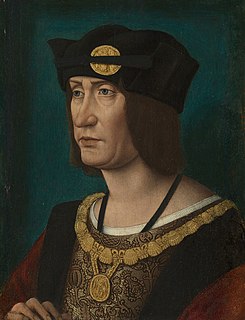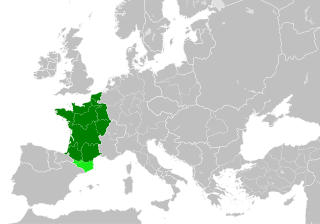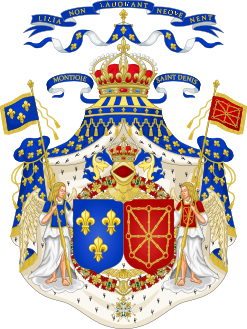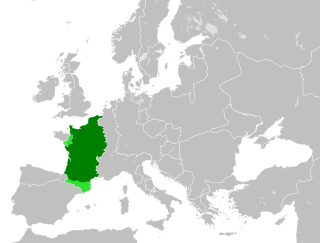A duke (male) can either be a monarch ranked below the emperor, king, and grand duke ruling over a duchy or a member of royalty or nobility, historically of highest rank, below princes of nobility and grand dukes. The title comes from French duc, itself from the Latin dux, 'leader', a term used in republican Rome to refer to a military commander without an official rank, and later coming to mean the leading military commander of a province. In most countries, the word duchess is the female equivalent.

Louis XII was King of France from 1498 to 1515 and King of Naples from 1501 to 1504. The son of Charles, Duke of Orléans, and Maria of Cleves, he succeeded his 2nd cousin once removed, Charles VIII, who died without direct heirs in 1498.

The French Wars of Religion were a prolonged period of war and popular unrest between Catholics and Huguenots in the Kingdom of France between 1562 and 1598. It is estimated that three million people perished in this period from violence, famine, or disease in what is considered the second deadliest religious war in European history.

In France under the Old Regime, the Estates General or States-General was a legislative and consultative assembly of the different classes of French subjects. It had a separate assembly for each of the three estates, which were called and dismissed by the king. It had no true power in its own right as, unlike the English parliament, it was not required to approve royal taxation or legislation. It served as an advisory body to the king, primarily by presenting petitions from the various estates and consulting on fiscal policy.

The Duchy of Brittany was a medieval feudal state that existed between approximately 939 and 1547. Its territory covered the northwestern peninsula of Europe, bordered by the Atlantic Ocean on the west, the English Channel to the north. It was less definitively bordered by the Loire River to the south, and Normandy and other French provinces to the east. The Duchy was established after the expulsion of Viking armies from the region around 939. The Duchy, in the 10th and 11th centuries, was politically unstable, with the dukes holding only limited power outside their own personal lands. The Duchy had mixed relationships with the neighbouring Duchy of Normandy, sometimes allying itself with Normandy, and at other times, such as the Breton-Norman War, entering into open conflict.

The Kingdom of France in the Middle Ages was marked by the fragmentation of the Carolingian Empire and West Francia (843–987); the expansion of royal control by the House of Capet (987–1328), including their struggles with the virtually independent principalities that had developed following the Viking invasions and through the piecemeal dismantling of the Carolingian Empire and the creation and extension of administrative/state control in the 13th century; and the rise of the House of Valois (1328–1589), including the protracted dynastic crisis of the Hundred Years' War with the Kingdom of England (1337–1453) compounded by the catastrophic Black Death epidemic (1348), which laid the seeds for a more centralized and expanded state in the early modern period and the creation of a sense of French identity.

The estates of the realm, or three estates, were the broad orders of social hierarchy used in Christendom from the Middle Ages to early modern Europe. Different systems for dividing society members into estates developed and evolved over time.

Francis II of Brittany was Duke of Brittany from 1458 to his death. He was the grandson of John IV, Duke of Brittany. A recurring theme in Francis' life would be his quest to maintain the quasi-independence of Brittany from France. As such, his reign was characterized by conflicts with King Louis XI of France and with his daughter, Anne of France, who served as regent during the minority of her brother, King Charles VIII. The armed and unarmed conflicts from 1465-1477 and 1484–1488 have been called the "War of the Public Weal" and the Mad War, respectively.

The now-extinct title of Earl of Richmond was created many times in the Peerage of England. The earldom of Richmond was initially held by various Breton nobles associated with the Ducal crown of Brittany; sometimes the holder was the Breton Duke himself, including one member of the cadet branch of the French Capetian dynasty. The historical ties between the Ducal crown of Brittany and this English Earldom were maintained ceremonially by the Breton dukes even after England ceased to recognize the Breton Dukes as Earls of England and those dukes rendered homage to the King of France, rather than the English crown. It was then held either by members of the English royal families of Plantagenet and Tudor, or English nobles closely associated with the English crown. It was eventually merged into the English crown during the reign of Henry VII and has been recreated as a Dukedom.

The Estates General of 1789 was a general assembly representing the French estates of the realm: the clergy, the nobility, and the commoners. It was the last of the Estates General of the Kingdom of France. Summoned by King Louis XVI, the Estates General of 1789 ended when the Third Estate formed the National Assembly and, against the wishes of the King, invited the other two estates to join. This signaled the outbreak of the French Revolution.

The Angevin Empire describes the possessions of the Angevin kings of England who held lands in England and France during the 12th and 13th centuries. Its rulers were Henry II, Richard I (r. 1189–1199), and John (r. 1199–1216). The Angevin Empire is an early example of a composite state.

The French nobility was a privileged social class in France during the Middle Ages and the Early Modern period to the revolution in 1790. The nobility was revived in 1805 with limited rights as a titled elite class from the First Empire to the fall of the July Monarchy in 1848, when all privileges were permanently abolished. Hereditary titles, without privileges, continued to be granted until the Second Empire fell in 1870. They survive among their descendants as a social convention and as part of the legal name of the corresponding individuals.

In medieval history, West Francia or the Kingdom of the West Franks refers to the western part of the Frankish Empire established by Charlemagne. It represents the earliest stage of the Kingdom of France, lasting from about 840 until 987. West Francia emerged out of the partition of the Carolingian Empire in 843 under the Treaty of Verdun following the death of Charlemagne's son, Louis the Pious.

The House of Montfort was a Breton-French noble family, which reigned in the Duchy of Brittany from 1365 to 1514. It was a cadet branch of the House of Dreux; it was thus ultimately part of the Capetian dynasty. It should not be confused with the older House of Montfort which ruled as Counts of Montfort-l'Amaury.

The Ancien Régime, also known as the Old Regime was the political and social system of the Kingdom of France from the Late Middle Ages until the French Revolution of 1789, which led to the abolition (1792) of hereditary monarchy and of the feudal system of the French nobility. The late Valois and Bourbon dynasties ruled during the Ancien Régime. The term is occasionally used to refer to the similar feudal systems of the time elsewhere in Europe such as that of Switzerland.

The Parliament of Brittany was one of the parlements, a court of justice under the French Ancien Régime, with its seat at Rennes. The last building to house the Parliament still stands and now houses the Rennes Court of Appeal, the natural successor of the Parliament.

The Pontcallec conspiracy was a rebellion that arose from an anti-tax movement in Brittany between 1718 and 1720. This was at the beginning of the Régence (Regency), when France was controlled by Philippe II, Duke of Orléans during the childhood of Louis XV. Led by a small faction of the nobility of Brittany, it maintained links with the ill-defined Cellamare conspiracy, to overthrow the Regent in favour of Philip V of Spain, who was the uncle of Louis XV. Poorly organised, it failed, and four of its leaders were beheaded in Nantes. The aims of the conspirators are disputed. In the 19th and early 20th century it was portrayed as a proto-revolutionary uprising or as a Breton independence movement. More recent commentators consider its aims to have been unclear.

The union of Brittany and France was a critical step in the formation of modern-day France. Brittany had been a semi-independent component of the Kingdom of France since Clovis I was given authority over the Gallo-Roman domain during the 5th century. It was first recorded as a "duchy" during the rule of Nominoe in 846. Over the centuries, the fealty demonstrated by the Duchy of Brittany toward the French king depended significantly on the individuals holding the two titles, as well as the involvement of the English monarchy at that particular time. The reign of Francis II, Duke of Brittany, was at an especially crucial time, as the nobles struggled to maintain their autonomy against the increasing central authority desired by Louis XI of France. As a result of several wars, treaties, and papal decisions, Brittany was united with France through the eventual marriage of Louis XI's son Charles VIII to the heiress of Brittany, Anne in 1491. However, because of the different systems of inheritance between the two realms, the crown and the duchy were not held by the same hereditary claimant until the reign of Henry II, beginning 1547.
The Stamenti was the parliament of Sardinia, consisting of representatives of the three estates of the realm.
















